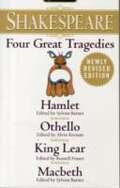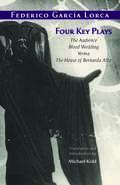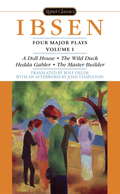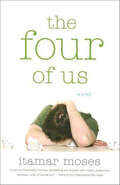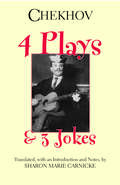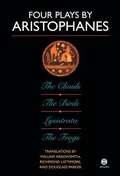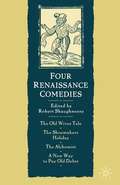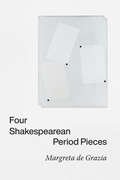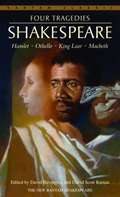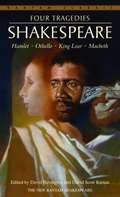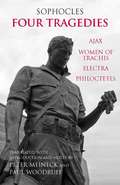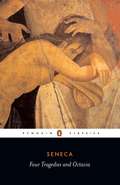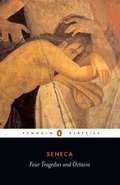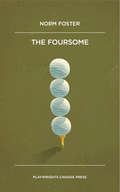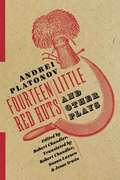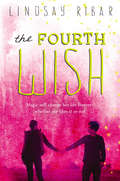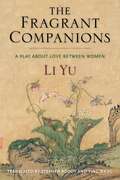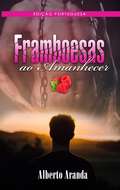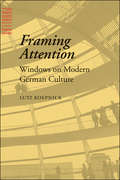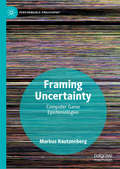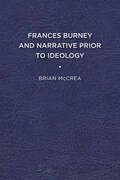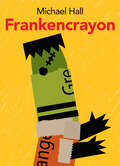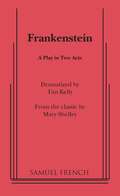- Table View
- List View
Four Great Tragedies: Hamlet, Macbeth, King Lear,Othello
by William Shakespeare Sylvan BarnetThe greatest works of tragedy from the Bard, this book features Hamlet, Othello, King Lear and Macbeth.
Four Key Plays: The Audience, Blood Wedding, Yerma, The House of Bernarda Alba
by Federico García LorcaIn addition to a substantial introduction to the life and works of Federico García Lorca—avant-garde poet, playwright, and soul of Spain's "Generation of '27"—this collection features vibrant new English translations of four of his plays. The legacy of a dramatic, religious, and social iconoclast whose death made him a martyr of the left in Civil-War Spain and who today is embraced as a gay icon shines through in Michael Kidd's stage-worthy renderings of Yerma, Blood Wedding, The House of Bernarda Alba, and a more experimental play, The Audience, a kaleidoscopic exploration of sexual identity and theater.
Four Major Plays, Volume I
by Henrik Ibsen Rolf Fjelde Joan TempletonFour Major Plays: Volume IA Doll HouseThe Wild DuckHedda GablerThe Master BuilderAmong the greatest and best known of Ibsen's works, these four plays brilliantly exemplify his landmark contributions to the theater: his realistic dialogue, probing of social problems, and depiction of characters' inner lives as well as their actions. Rich in symbolism and often autobiographical, each of these dramas deals convincingly and provocatively with such universal themes as greed, fear, and sexual hostility, and confronts the eternal conflict between reality and illusion. These Rolf Fjelde translations have been widely acclaimed as the definitive versions of the major works of the father of modern theater.Translated and with a Foreword by Rolf Fjeldeand a New Afterword by Joan Templeton
The Four of Us: A Play
by Itamar MosesFrom the author of Bach at Leipzig (Faber, 2005) comes a play about loyalty, integrity, and the price of success. When Benjamin's first novel vaults him into literary stardom, his friend David, a struggling playwright, is thrilled for his newfound success . . . or is he? Should Benjamin help David by using his new connections? Can David even expect such favors from his friend? More importantly, who should pick up the tab at lunch? Hailed as a writer who "makes the kinds of stylistic gambles that should be applauded" (Eric Grode, The New York Sun), Itamar Moses proves once again with this inventive exploration of the evershifting ground of friendship that he is a playwright to watch. The Four of Us had its off-Broadway premiere in March 2008 at Manhattan Theatre Club."Clever [and] smart…[The Four of Us] suggests that Moses will be displaying a big range as his career unfolds."--The San Diego Union-Tribune
Four Plays and Three Jokes
by Anton Chekhov Sharon Marie CarnickeThis volume offers lively and accurate translations of Chekhov's major plays and one-acts (complete contents listed below) along with a superb Introduction focused on the plays' remarkably enduring power to elicit the most widely divergent of responses, the life of the playwright in its historical and aesthetic contexts, suggestions for reading the plays under a microscope, and notes designed to bring Chekhov's world into immediate focus--everything needed to examine his drama with fresh eyes and on its own artistic terms.
Four Plays by Aristophanes: The Clouds; The Birds; Lysistrata; The Frogs
by William Arrowsmith Aristophanes Richmond Lattimore Douglas Parker Douglass Parker<p>Whether his target is the war between the sexes or his fellow playwright Euripides, Aristophanes is the most important Greek comic dramatist—and one of the greatest comic playwrights of all time. His writing—at once bawdy and delicate—brilliantly fuses serious political satire with pyrotechnical bombast, establishing the tradition of comedy as high art. His messages are as timely and relevant today as they were in ancient Greece, and his plays still provoke laughter—and thought. <p>This volume features four celebrated masterpieces: Lysistrata, The Frogs, The Birds, and The Clouds, translated by three of the most distinguished translators and classicists of our time.</p>
Four Renaissance Comedies: A New Way to Pay Old Debts
by Robert ShaughnessyThis anthology of four Elizabethan and Jacobean comedies (George Peele's The Old Wives Tale, Ben Jonson's The Alchemist, Philip Massinger's A New Way to Pay Old Debts, and Thomas Dekker's The Shoemaker's Holiday) offers fully modernized and annotated texts and demonstrates the range and variety of English Renaissance comedy. The general introduction surveys the theory and practice of early modern comedy in its time and ours, and each play is prefaced by a brief introduction addressing issues of authorship, theatrical provenance and subsequent performance history.
Four Shakespearean Period Pieces
by Margreta de GraziaIn the study of Shakespeare since the eighteenth century, four key concepts have served to situate Shakespeare in history: chronology, periodization, secularization, and anachronism. Yet recent theoretical work has called for their reappraisal. Anachronisms, previously condemned as errors in the order of time, are being hailed as alternatives to that order. Conversely chronology and periods, its mainstays, are now charged with having distorted the past they have been entrusted to represent, and secularization, once considered the driving force of the modern era, no longer holds sway over the past or the present. In light of this reappraisal, can Shakespeare studies continue unshaken? This is the question Four Shakespearean Period Pieces takes up, devoting a chapter to each term: on the rise of anachronism, the chronologizing of the canon, the staging of plays “in period,” and the use of Shakespeare in modernity’s secularizing project. To read these chapters is to come away newly alert to how these fraught concepts have served to regulate the canon’s afterlife. Margreta de Grazia does not entirely abandon them but deftly works around and against them to offer fresh insights on the reading, editing, and staging of the author at the heart of our literary canon.
Four Tragedies: Hamlet, Othello, King Lear, Macbeth
by William Shakespeare David Bevington David Scott KastanThe greatest works of tragedy from the Bard, this book features "Hamlet," "Othello," "King Lear" and "Macbeth."
Four Tragedies: Hamlet, Othello, King Lear, Macbeth
by William Shakespeare David Bevington David Scott KastanHamletOne of the most famous plays of all time, the compelling tragedy of the young prince of Denmark who must reconcile his longing for oblivion with his duty to avenge his father's murder is one of Shakespeare's greatest works. The ghost, Ophelia's death and burial, the play within a play, and the breathtaking swordplay are just some of the elements that make Hamlet a masterpiece of the theater.OthelloThis great tragedy of unsurpassed intensity and emotion is played out against Renaissance splendor. The doomed marriage of Desdemona to the Moor Othello is the focus of a storm of tension, incited by the consummately evil villain Iago, that culminates in one of the most deeply moving scenes in theatrical history.King LearHere is the famous and moving tragedy of a king who foolishly divides his kingdom between his two wicked daughters and estranges himself from the young daughter who loves him-a theatrical spectacle of outstanding proportions.MacbethNo dramatist has ever seen with more frightening clarity into the heart and mind of a murderer than has Shakespeare in this brilliant and bloody tragedy of evil. Taunted into asserting his "masculinity" by his ambitious wife, Macbeth chooses to embrace the Weird Sisters' prophecy and kill his king-and thus, seals his own doom.Each Edition Includes:* Comprehensive explanatory notes * Vivid introductions and the most up-to-date scholarship * Clear, modernized spelling and punctuation, enabling contemporary readers to understand the Elizabethan English* Completely updated, detailed bibliographies and performance histories * An interpretive essay on film adaptations of the play, along with an extensive filmographyFrom the Paperback edition.
Four Tragedies: Ajax, Women of Trachis, Electra, Philoctetes
by Paul Woodruff Peter Meineck SophoclesMeineck and Woodruff's new annotated translations of Sophocles' Ajax, Women of Trachis, Electra, and Philoctetes combine the same standards of accuracy, concision, clarity, and powerful speech that have so often made their Theban Plays a source of epiphany in the classroom and of understanding in the theatre. Woodruff's Introduction offers a brisk and stimulating discussion of central themes in Sophoclean drama, the life of the playwright, staging issues, and each of the four featured plays.
Four Tragedies and Octavia
by SenecaBased on the legends used in Greek drama, Seneca's plays are notable for the exuberant ruthlessness with which disastrous events are foretold and then pursued to their tragic and often bloodthirsty ends. Thyestes depicts the menace of an ancestral curse hanging over two feuding brothers, while Phaedra portrays a woman tormented by fatal passion for her stepson. In The Trojan Women, the widowed Hecuba and Andromache await their fates at the hands of the conquering Greeks, and Oedipus follows the downfall of the royal House of Thebes. Octavia is a grim commentary on Nero's tyrannical rule and the execution of his wife, with Seneca himself appearing as an ineffective counsellor attempting to curb the atrocities of the emperor.
Four Tragedies And Octavia
by Seneca E. F. WatlingBased on the legends used in Greek drama, Seneca's plays are notable for the exuberant ruthlessness with which disastrous events are foretold and then pursued to their tragic and often bloodthirsty ends. Thyestes depicts the menace of an ancestral curse hanging over two feuding brothers, while Phaedra portrays a woman tormented by fatal passion for her stepson. In The Trojan Women, the widowed Hecuba and Andromache await their fates at the hands of the conquering Greeks, and Oedipus follows the downfall of the royal House of Thebes. Octavia is a grim commentary on Nero's tyrannical rule and the execution of his wife, with Seneca himself appearing as an ineffective counsellor attempting to curb the atrocities of the emperor. For more than seventy years, Penguin has been the leading publisher of classic literature in the English-speaking world. With more than 1,700 titles, Penguin Classics represents a global bookshelf of the best works throughout history and across genres and disciplines. Readers trust the series to provide authoritative texts enhanced by introductions and notes by distinguished scholars and contemporary authors, as well as up-to-date translations by award-winning translators.
The Foursome
by Norm FosterRick, Ted, Donnie, and Cameron are home for their fifteen-year college reunion; a great time to go out for a game of golf and catch up on each other’s lives. Unlike their college days, the conversation doesn’t include talk of beer and final exams, but of colonoscopies, home-security systems, alcoholism, Buddhism, and more.
Fourteen Little Red Huts and Other Plays (Russian Library)
by Andrei PlatonovIn this essential collection of Andrei Platonov's plays, the noted Platonov translator Robert Chandler edits and introduces The Hurdy-Gurdy (translated by Susan Larsen), Fourteen Little Red Huts (translated by Chandler), and Grandmother's Little Hut (translated by Jesse Irwin). Written in 1930 and 1933, respectively, The Hurdy-Gurdy and Fourteen Little Red Huts constitute an impassioned and penetrating response to Stalin's assault on the Soviet peasantry. They reflect the political urgency of Bertolt Brecht and anticipate the tragic farce of Samuel Beckett but play out through dialogue and characterization that is unmistakably Russian. This volume also includes Grandmother's Little Hut, an unfinished play that represents Platonov's later, gentler work.
Fourteen Little Red Huts and Other Plays
by Andrei Platonov Robert ChandlerIn this essential collection of Andrei Platonov's plays, the noted Platonov translator Robert Chandler edits and introduces The Hurdy-Gurdy (translated by Susan Larsen), The Fourteen Little Red Huts (translated by Chandler), and Grandmother's Little Hut (translated by Jesse Irwin). Written in 1930 and 1933, respectively, The Hurdy-Gurdy and The Fourteen Little Red Huts constitute an impassioned and penetrating response to Stalin's assault on the Soviet peasantry. They reflect the political urgency of Bertolt Brecht and anticipate the tragic farce of Samuel Beckett but play out through dialogue and characterization that is unmistakably Russian. This volume also includes Grandmother's Little Hut, an unfinished play that represents Platonov's later, gentler work.
The Fourth Wish
by Lindsay RibarHere's what Margo McKenna knows about genies: She's seen Aladdin more times than she can count; she's found a magic genie ring and made her three allotted wishes; she's even fallen head over heels in love with Oliver, the cute genie whose life she saved by fighting off another genie. But none of this prepared her for the shock of becoming a genie herself. Everything Margo's taken for granted--graduating high school, going to college, hating math, performing in the school musical, even being a girl--is in question. Just at a time when she's trying to figure out who she wants to be, Margo is forced to become whomever her master wants. But Margo is also coming into a power she never imagined she'd have. How will she reconcile the two? And where will she and Oliver stand when she's done? Fans of Every Day and Anna and the French Kiss will love this romantic, magical, and surprising conclusion to The Art of Wishing.
The Fragility of Goodness: Luck and Ethics in Greek Tragedy and Philosophy
by Martha C. NussbaumThis book is a study of ancient views about "moral luck. " It examines the fundamental ethical problem that many of the valued constituents of a well-lived life are vulnerable to factors outside a person's control, and asks how this affects our appraisal of persons and their lives. The Greeks made a profound contribution to these questions, yet neither the problems nor the Greek views of them have received the attention they deserve. This updated edition contains a new preface.
The Fragrant Companions: A Play About Love Between Women (Translations from the Asian Classics)
by Li YuTwo young gentry women meet by chance at a nunnery in Yangzhou, where they fall in love at first sight. After they exchange poetry and recognize each other’s literary talents, their emotional bond deepens. They conduct a mock wedding ceremony at the nunnery and hatch a plan to spend the rest of their lives together. Their schemes are stymied by a series of obstacles, but in the end the two women find an unlikely resolution—a ménage-à-trois marriage.The Fragrant Companions is the most significant work of literature that portrays female same-sex love in the entire premodern Chinese tradition. Written in 1651 by Li Yu, one of the most inventive and irreverent literary figures of seventeenth-century China, this play is at once an unconventional romantic comedy, a barbed satire, and a sympathetic portrayal of love between women. It offers a sensitive portrait of the two women’s passion for each other, depicts their intellectual pursuits and resourcefulness, and celebrates their partial triumph over social convention. At the same time, Li caustically mocks the imperial examination system and deflates the idealized image of the male scholar.The Fragrant Companions is both an indispensable source for students and scholars of gender and sexuality in premodern China and a compelling work of literature for all readers interested in China’s rich theatrical traditions.
Frambuesas ao Amanhecer
by Alberto Aranda de la GalaA história eo caminho de um jovem que, depois de un eventual happenour na sua vida - a morte do seu melhor amigo - decide sair da aldeia onde vive y viaja para una gran cita en busca de la fama y hace exito ... custe o que custar. Recriada nos anos 90, em Espanha.
Framing Attention: Windows on Modern German Culture (Parallax: Re-visions of Culture and Society)
by Lutz KoepnickIn Framing Attention, Lutz Koepnick explores different concepts of the window—in both a literal and a figurative sense—as manifested in various visual forms in German culture from the nineteenth century to the present. He offers a new interpretation of how evolving ways of seeing have characterized and defined modernity.Koepnick examines the role and representation of window frames in modern German culture—in painting, photography, architecture, and literature, on the stage and in public transportation systems, on the film screen and on television. He presents such frames as interfaces that negotiate competing visions of past and present, body and community, attentiveness and distraction. From Adolph Menzel's window paintings of the 1840s to Nam June Paik's experiments with television screens, from Richard Wagner's retooling of the proscenium stage to Adolf Hitler's use of a window as a means of political self-promotion, Framing Attention offers a theoretically incisive understanding of how windows shape and reframe the way we see the world around us and our place within it.
Framing Uncertainty: Computer Game Epistemologies (Performance Philosophy)
by Markus RautzenbergThis book presents a compilation of articles on the subject of game studies written over the last ten years. These texts reflect a decade of research in European computer game studies from a theoretical perspective that combines philosophy, cultural studies, visual studies, and media studies in a way that is unique to a specific type of media theory developed in Germany over the last thirty years. This theory differs quite significantly from media studies as usually conceived in Anglo-American academia, providing new perspectives that are rooted in continental philosophical traditions ranging from phenomenology to post-structuralism and newer forms of “presence studies” in aesthetic theory. The book provides (1) an introduction to a continental approach to game philosophy; (2) an aesthetic theory of computer games rooted in concepts of performativity and epistemology; and (3) an introduction to an interdisciplinary approach to game studies that is based on philosophical perspectives on the subject matter.
Frances Burney and Narrative Prior to Ideology
by Brian McCreaFrances Burney and Narrative Prior to Ideology works between Burney’s Journals and Letters and her fiction more thoroughly than any study of her in the past twenty-five years. By doing so, it offers significant reinterpretations of Burney’s four novels: Evelina, Cecilia, Camilla, and The Wanderer. It describes Burney’s eluding the major modern–isms through which critics have tried to read her: Feminism (with its “gendering” of beauty and reversal of gender roles); Capitalism and its Marxist critique (here the details of Burney’s housekeeping become important); Professionalism (as a response to status inconsistency and class conflict); and Ian Watt’s “Formal Realism” (Burney perhaps saved the novel from a sharp decline it suffered in the 1770s, even as she tried to distance herself from the genre). Burney’s most successful writing appeared before the coining of “ideology.” But her standing “prior to ideology” is not a matter of chronological accident. Rather, she quietly but forcefully resisted shared explanations—domesticity as model for household management, debt as basis for family finance, professional status as a means to social confidence, the novel as the dominant literary genre—that became popular during her long and eventful life. Frederic Jameson has described Paul de Man, “in private conversation,” claiming, “Marxism . . . has no way of understanding the eighteenth century.” Frances Burney and Narrative Prior to Ideology conjoins Burney’s “eighteenth-centuryness” with her modernity. Published by University of Delaware Press. Distributed worldwide by Rutgers University Press.
Frankencrayon
by Michael HallIngenuity and surprise rule in this funny and colorful companion to Red: A Crayon’s Story written and illustrated by Michael Hall, the New York Times–bestselling creator of My Heart Is Like a Zoo.The crayons are ready to tell the thrilling tale of Frankencrayon. The costumes are made, the roles are cast, the pages are all set—but then disaster strikes. Someone has scribbled on the page! Hideous! Horrifying! The story can’t go on! Try as they might, the crayons can’t erase the scribble, and this picture book must be canceled. Until the crayons playing the title role of Frankencrayon think of a solution, that is. Michael Hall breaks borders and invites readers behind the scenes with his irresistible, clever style and bold artwork. A book about seeing beauty in unexpected places and the magic of storytelling.
Frankenstein
by Tim Kelly Mary ShelleyDrama / Character: 4 male, 4 femaleScenery: Interior. Victor Frankenstein, a brilliant young scientist, returns to his Swiss chateau to escape a terrible pursuer. No one can shake free the dark secret that terrifies him: not his mother, nor his fiancee, nor his best friend. Even the pleading of a gypsy girl accused of murdering Victor's younger brother falls on deaf ears, for Victor has brought into being a creature made from pieces of the dead. The creature tracks Victor to his sanctuary to demand a bride to share its loneliness. Against his better judgement, Victor agrees and soon the household is invaded by murder, despair and terror! . "Thrills... laughs... true suspense." Arizona Republic. . "In Tim Kelly's thoughtful version of the classic tale, the results are surprisingly thought provoking and highly entertaining." Palos Verdes News
